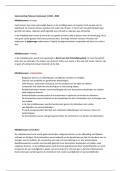Samenvatting
Summary - Clinical Assessment; Psychodiagnostic Decision Making
- Instelling
- Radboud Universiteit Nijmegen (RU)
- Boek
- Clinical Assessment
A complete summary of the book Clinical Assessment: Psychodiagnostic Decision Making by Witteman, Van der Heijden and Claes (2018). From chapter 2 onward, the summary is mainly written in full text. This book is required literature for the course Clinical Assessment and Decision Making at the Rad...
[Meer zien]






